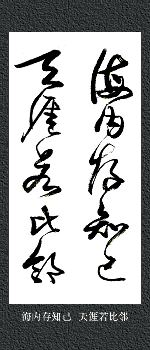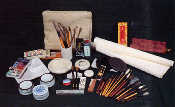The history of Chinese calligraphy is as long as that of China itself. Calligraphy is a special category in China's world of fine arts and one of the most challenging Chinese art forms for a foreigner to appreciate or master. Calligraphy, orshufa, is one of the four basic skills and disciplines of the Chinese literati, together with painting (hua), stringed musical instruments (qin) and board games (qi).
 Classification
Classification
 Studying Chinese calligraphy one must learn something about the origins of Chinese characters, which can be traced to inscriptions on bones, tortoise shells and bronzeware of which the earliest identifiable characters belonged to the Shang Dynasty (16th-11th century BC).
Studying Chinese calligraphy one must learn something about the origins of Chinese characters, which can be traced to inscriptions on bones, tortoise shells and bronzeware of which the earliest identifiable characters belonged to the Shang Dynasty (16th-11th century BC).
Through the centuries Chinese characters have changed constantly and are mainly divided into five categories today: the seal script (zhuan shu), official script (li shu), regular script (kai shu), running script (xing shu) and cursive script (cao shu). Chinese calligraphy, like script itself, has developed the above-mentioned styles according to various schools.
Seal characters, which were developed in the Western Zhou Dynasty (11th century-711BC) and are the earliest form of writing after oracle inscriptions, were the first unified and standardized characters of the nation. Official script is a simplified form of script since seal characters were too complicated for ancient officials to use when copying documents. Official script led to the emergence of regular script, which was square in form, non-cursive and architectural in style, in the third century. Official script also gave birth to cursive script where characters are often joined with the last stroke of the first that merges into the initial stroke of the next character, which made the writing process much faster. Running script falls somewhere between regular and cursive scripts.
Calligraphy is an art form that involves a great deal of theory and requires many skills; consequently there are few calligraphers that have reached the highest realm of calligraphy. Among the most outstanding calligraphers in ancient China were Wang Xizhi, Ouyang Xun, Yan Zhengqing, and Liu Gongquan, who are known for pioneering their own styles.
 'Four Treasures of the Study'
'Four Treasures of the Study'
 To produce Chinese characters one will need a brush, paper, ink stick and ink stone, commonly referred to as the "Four Treasures of the Study". To learn calligraphy, it is necessary to learn about these tools.
To produce Chinese characters one will need a brush, paper, ink stick and ink stone, commonly referred to as the "Four Treasures of the Study". To learn calligraphy, it is necessary to learn about these tools.
While brushes are varied, white-goat-hair, black-rabbit-hair and yellow-weasel-hair brushes are the main ones. On the basis of function, brushes are classified into three groups: hard, soft and both. Brush handles are usually made of bamboo, wood, lacquer or porcelain; ivory or jade handles are rare and precious.
The ink stick is a unique pigment used for Chinese traditional painting and calligraphy. The most famous ink stick ishui mo(Anhui ink stick), made of pines that grow on Huangshan Mountain in Anhui Province. Clean water is needed to grind the ink stick, which must be balanced in the hand during the grinding or rubbing process. Press hard and rub lightly, slowly and evenly against the ink slab until a thick, liquid-ink forms.
Paper was invented by Cai Lun in the Eastern Han Dynasty (25-220). While paper comes in many varieties, Xuan paper, produced in the Jing Prefecture of Xuanzhou (today's Anhui Province), is considered the best for Chinese calligraphy. The paper is soft and fine textured, suitable for conveying the artistic expression of both Chinese calligraphy and painting. With a good tensile strength and mothproof quality, the paper can be preserved for a long time.
Ink stones or ink slabs have been classified into three categories:Duan,SheandTao. Features common to all three ink slabs are the stone's hardness and fineness. Although the stone is hard and fine, it is not dry or slippery. Using a hard, smooth stone, liquid ink can be produced easily by rubbing the ink stick against the stone.
By controlling the flexibility of the brush, the concentration of the ink and the absorbency of the paper, the artist can produce an infinite variety of calligraphic styles and forms.
 Calligraphy: Leader of All Art Forms
Calligraphy: Leader of All Art Forms
Few nations in the world have calligraphy as a form of art. In China, calligraphy has maintained a close rapport with the country's cultural development.
Calligraphy is an expressive art. According to an old Chinese saying, "the way characters are written is a portrait of the person who writes them." Expressing the abstract beauty of lines and rhythms, calligraphy is a reflection of a person's emotions, moral integrity, character, educational level, accomplishments in self-cultivation, intellectual tastes and approach to life. Chinese characters, which convey ideas, are regarded as the most abstract and sublime art form.
Calligraphy is also a practical fine art. Exotic calligraphic inscriptions written on paper, wooden plaques or stone tablets serve as decorations of a deep artistic value.
Calligraphy manifests the basic characteristics of all Chinese arts. Closely associated with paintings -- the two leaders of Chinese art forms -- calligraphy takes precedence over painting since it greatly inspired the art of painting. Moreover, calligraphy has influenced other typically Chinese art forms like classical poetry, seal-cutting, sculpture, traditional music and dance, architecture and handicrafts.
Calligraphy is a mental exercise that coordinates the mind and body. It is a most relaxing yet highly disciplined exercise for physical and spiritual well-being. Historically, many calligraphic artists lived to a ripe, old age.
 An Art of the Orient
An Art of the Orient
Chinese calligraphy is an Oriental art. Like chopsticks, calligraphy was once entirely Chinese, but as Chinese culture spread to Korea, Japan, and Singapore, calligraphy became a unique feature of the Oriental art.
Calligraphy is even wildly accepted by the West; as once Picasso said, "Had I been born Chinese, I would have been a calligrapher, not a painter." Many calligraphic elements are being adopted by modern western art.
